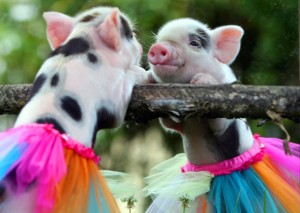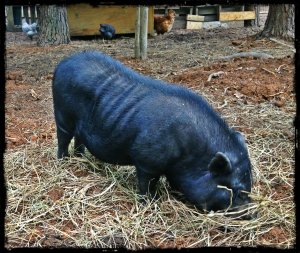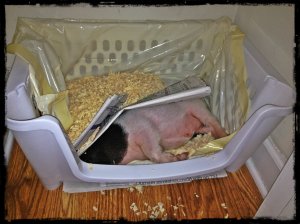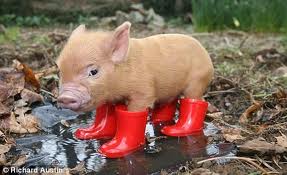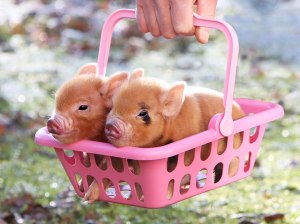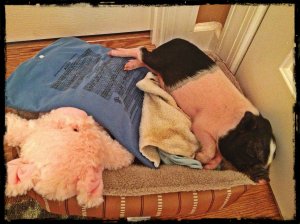With the welcoming of Oliver to the homestead, I have gotten quite a few questions about owning a mini pig. Below is some general info I have learned through research and experience. I hope you will find it useful!
Before you get excited about the idea of owning a piglet, you will need to make sure you are allowed to have one in your area. This can be found by contacting your local zoning office. Once you get the legal confirmation, your journey can officially begin.
Why be a piggy parent?
Mini Pot Bellied pigs are a unique choice of pet. They are loving, social, smart and fun. With some training, they can live happily alongside you and your family in your home. Pigs do not shed and are hypo-allergenic, so they are a wonderful choice if you or a family member have allergies to the typical cats and dogs. You can train your mini pig to do all kinds of fun tricks and I guarantee they will be the topic of conversation anytime you have folks over. And of course, piglets are also one of the cutest animals you have ever seen!
Where do piglets come from?
The concept of “mini” and “micro” piglets is a controversial one. There are many people who argue these creatures do not exist are only underfed piglets. This is why it is absolutely vital to find a reliable breeder with a lot of positive references and years of experience. Mini and micro pig are sometimes used interchangeably, but most breeders have specific size restraints attached to these terms.
Breeders have “bred down” the sizing of these mini piglets. This means that with each litter, they keep the smallest member in hope that when they reproduce, they will produce smaller piglets. The same is done generation after generation. I do not see this system any different than “toy” breeds of dogs, but some people do.
When choosing a breeder make sure:
- They have reliable references
- They have parents on site (who are at least a few years old)
- They have been breeding for at least several years
- They have some type of health guarantee or vet assessment
We chose a breeder that was in another state and Oliver was flown to us on an airplane (read about that misadventure HERE). This can be risky, but I felt confident the breeder we chose was being honest and up front. She also had many references and years of experience.
Piggy Price
I know you are thinking, if piglets are really that great of companions and are so easy to train, than why don’t more people have them? One of the reasons is likely the extreme cost of these little critters. The smaller the breeder claims they are, the more expensive they will be. These guys can cost anywhere from $800-$3000. While this price might seem pretty large, I figured if Oliver lives around 20 years, his cost is about $50 a year and that was totally manageable (and also how I convinced my husband to get him!).
I urge you to be cautious for anyone selling piglets for less than $800. You will get what you pay for. For example, Houidini was also a “mini pig” who we purchased from a not so great breeder for a few hundred dollars and he is around 60 pounds and very solid. I can’t imagine him in the house! You will see adds on Craigslist for “mini piglets-$200” I would strongly recommend not purchasing them from these type of breeders.
Training Your Piglet
With the right training, pigs are able to happily live indoors. If you are buying a micro pig from a breeder, the understanding is it will be an inside pig. Bringing home a micro pig is comparable to bringing home a puppy. Just like puppies, pigs need a lot of attention and training.
It is important to only allow your little one in certain “safe” parts of the house until they are older and able to understand what you want from them. Pigs are one of the smartest animals on earth (ranked number 4 by whoever decides lists such as this) and most folks say they are easier to train than puppies.
Piglets, just like puppies or children, will get into trouble when left unattended. They love to root and explore with their little piggy snouts and this can lead them to mischief. Pigs are also very good at watching how you open the refrigerator (or pantry) and when they are grown up piggies, are able to nose open the fridge and help themselves to your leftovers!
Pigs are extremely social and do well with children, dogs and cats. Pigs and dogs are typically able to co-exist without any problems. Oliver and my pups get along great. My dogs are very mild tempered and Oliver loves to sniff and nibble on their toes! The main thing to be aware of is making sure your dog doesn’t figure out your piggy is where bacon comes from! Pigs are animals of prey and dogs are natural predators so pigs can suffer extensive injuries from dog attacks.
Pigs are instinctively hierarchical, so make sure your piggy knows you are head of the household. Start making this known the minute your pig is in your care. This doesn’t mean to be bossy and not treat your pig sweetly, but if he is doing something you do not approve of, do not let this behavior continue.
Don’t ever strike a pig. Particularly as piglets, you want them to associate people’s hands with positive touching not negative touching. Striking a pig will lead to them biting people’s hands and not wanting to be scratched. Pigs enjoy getting scratched as opposed to petting. Save the petting for your pups.
Potty Training
Potty training is the main challenge of raising your piglet. In nature, pigs are very clean animals. Contrary to how they are portrayed, pigs like a warm, dry bed and choose a designated potty spot. Houidini and Doyle (who are outside pigs) never use their houses (where they sleep) when they need to go the bathroom, but instead have a designated corner that they consistently use for potty breaks.
Oliver decided to use his litter box as a bed the first night he was here.
After I took out some of the soft pine shavings and replaced them with piggy poo, by day 3 he got the idea this was where he goes to potty. He has been consistently using the litter box since day 3. Keep in mind he is quarantined to a small area of the house.
You have two options when it comes to house breaking your piggy. You can litter box train them or teach them to go outside. Whichever you choose, stay consistent. Just like when house-breaking puppies, it takes time for them to learn. The main point is to reward good potty behavior with positive verbal praise and naughty potty behavior with a stern “No.” There will be accidents, so make sure to stock up on carpet cleaner and paper towels for the first few weeks of bringing your little one home.
I advise against rewarding your pig for proper potty behavior with treats. Pigs are so smart they will start faking using the potty because they know a tasty snack will follow.
Litter Box Training
Many people with indoor piggies choose litter box training because it is most convenient. This is why I chose it! Pigs have stumpy legs, so make sure the opening to the litter box isn’t too high for them to reach. I use a storage bin from Walmart with a litter box liner bag inside. This makes it easier to clean. Dog litter boxes are designed in a more pig-friendly fashion, but you will pay more for a “litter box.” Do not use cat litter in the litter box, pigs like to eat this and can cause deadly abdominal issues. Instead, use pine wood chips (not cedar) or newspaper.
With the inevitable accidents that will happen, place the paper towels you used to clean them inside the litter box until your piglet notices them. This will help place the scent in the box and show your little one that is where they are supposed to go. For the first few weeks, do not clean out the box every time they use it. You want to instill in your piggy that the box is the correct place to go. Pigs are creatures of habit, so pick one spot for the litter box and do not move it.
Outdoor Potty Training
Outdoor training requires much of what you would do for a puppy. Use a harness and leash and lead your piglet outside to a designated spot. When you first get your piglet, he will likely be very shy. It will take time to get him used to a harness so don’t expect to be able to put it right on the day you get him. Once they deliver what you want, make sure to immediately reward them with positive praise and take them immediately back inside. Don’t spend extra time outside until they are fully trained. This teaches them that being outside is where the magic happens, not inside on your expensive carpet.
Piggy Food
“Eat like a pig” is a statement that couldn’t be more accurate. Pigs love to eat. Pigs will continue to eat as much as you will feed them. They are extremely food motivated, which makes them easy to train. It is your job as a piggy mama or daddy to feed them responsibly so they do not end up being overweight and have the corresponding health problems.
You can purchase mini pig feed at Tractor Supply (and other feed stores-just call to be sure they carry it) and online. Be sure to offer fresh fruits (sparingly due to high sugar content) and vegetables in addition to their feed. Do not feed your piglet “hog feed” that you find at regular feed stores, this will cause them to grow very large. Of course an occasional cupcake or taste of ice cream won’t hurt them, but make sure to give treats in moderation. Do not feed your pig white potatoes or peels, these are rumored to be poisonous.
Pigs need lots of fresh water because they cannot sweat, so it is important to keep them well hydrated. Make sure your piglet has access to water at all times.
Piggy Sleep
Pigs like a warm place to sleep. They need several blankets so they can arrange them how the see fit. Pigs like to sleep in a nest, so provide enough blankets for them to cuddle into. Despite how irresistible it may be, I would encourage you to not let your piglet sleep with you. It may be fun now, but when they are full grown, they will happily nudge you out of the bed and make themselves right at home.
Spay and Neutering
This is an absolute must if you plan on keeping your new piglet inside. Once they start to come into sexual development (around 3 months old), the males will emit a not so pleasant smell. They will also start to “hug” anything they can get near. Males can also become territorial and aggressive if left intact. If you are local, I can give you several vets that care for pot bellied pigs. Most breeders will spay or neuter your little one before they come to live with you.
Piggy Hair Care
Pigs have sensitive skin with course hair covering their bodies. This hair needs to be brushed occasionally. Bathing should be done no more than once a month so it will not dry out their delicate skin. Use a gentle shampoo like puppy or baby wash. Start bathing early so your little one will be used to the process (treats help!). From time to time pigs may need their nails trimmed if they do not have access to ground that will help keep them filed down. Make sure to trim small increments off at a time so no vessels are cut. Touch piglet’s feet extensively when he is very little so he will be used to hoof care when he is older.
Piggy Vocals
Pigs are vocal creatures. They can snort, bark, squeal and scream. If you have never heard a pig scream, I strongly suggest you YouTube this. It is very important you know this sound and become comfortable with it. When you bring your adorable, innocent piglet home the first thing everyone will want to do is hold him or her. Instinctively piglets do not like their feet off the ground. Picking a piglet up simulates a predator lifting them away to danger. When you pick up a piglet initially you will hear the piglet scream bloody murder. And I mean bloody murder. The pitch and volume of this scream is impressive coming from their tiny body. However, this is nature doing what nature is intended to do and that is to protect its little ones.
Holding your piglet is something you will want to do as often as possible to show them no harm will come (treats help!). Hold them securely up against your chest with your arm under their legs and hooves. Once the piglet becomes desensitized and their trust is secured in you, the horror movie girl victim screams will cease. Be advised, this can take anywhere from a few days to a few weeks. I made sure we purchased from a breeder that socialized and held their piglets as early as possible. This has helped immensely with Oliver becoming more used to people in a shorter time frame.
————————
With proper care and attention your piglet will be a beloved pet and a wonderful addition to your family. These animals are not ones you can just leave in their crate all day and not spend any time with. Pigs are social animals and without this interaction they will become depressed and destructive. Choosing to purchase a pig is a big decision, especially since they can live up to twenty years. Make sure you do plenty of research and discuss the decision with your family. Piglets are ridiculously cute, but will eventually grow into a larger, cute but in a different way, pig.
Mini pigs need lots of love and company but in return they will be loyal, irreplaceable members of your family. Embarking on the adventure of adding a mini pig to your family will be one filled with love, laughter and entertainment.
